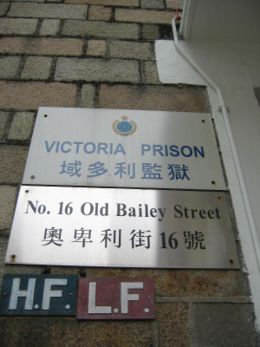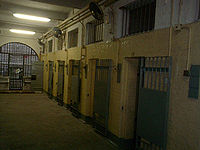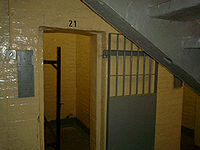
Victoria Prison
Encyclopedia



Hong Kong
Hong Kong is one of two Special Administrative Regions of the People's Republic of China , the other being Macau. A city-state situated on China's south coast and enclosed by the Pearl River Delta and South China Sea, it is renowned for its expansive skyline and deep natural harbour...
's first prison
Prison
A prison is a place in which people are physically confined and, usually, deprived of a range of personal freedoms. Imprisonment or incarceration is a legal penalty that may be imposed by the state for the commission of a crime...
. A testimony to the evolution of Hong Kong's correctional services, it had been the centre of the local prison system until it ceased operation in December 2005.
As part of the Central Police Station Compound, which also includes Central Police Station
Central Police Station
Central Police Station is a former police station, located at the eastern end of Hollywood Road, in Central, Hong Kong. It is awaiting development following its decommissioning.-History:...
, Victoria Prison is a declared monument of Hong Kong
Declared monuments of Hong Kong
Declared monuments of Hong Kong are places, structures or buildings legally declared to be "protected". In Hong Kong, declaring a monument requires consulting the Antiquities Advisory Board, the approval of the Chief Executive as well as the publication of the notice in government gazette.As of 12...
. It is located on Old Bailey Street
Old Bailey Street
Old Bailey Street is located in Central, Hong Kong. The name is derived from the Old Bailey, the Central Criminal Court in central London, United Kingdom....
in Central
Central, Hong Kong
Central is the central business district of Hong Kong. It is located in Central and Western District, on the north shore of Hong Kong Island, across Victoria Harbour from Tsim Sha Tsui, the southernmost point of Kowloon Peninsula...
on Hong Kong Island
Hong Kong Island
Hong Kong Island is an island in the southern part of the Hong Kong Special Administrative Region. It has a population of 1,289,500 and its population density is 16,390/km², as of 2008...
.
History
The Compound was built in 1841 and the Prison itself completed on 9 August 1841. It was originally known as the Victoria Gaol and is said to be the first western building constructed of durable material in Hong Kong. The Prison still retains the facade of Victorian architecture, having been built mostly of granite and brick. It is also the first prison in Hong Kong and an important part of Hong Kong's history.During World War II, the prison was occupied by the Japanese and most of the buildings were damaged by bombing. The prison was re-opened for use in 1946 after restoration. When Hong Kong was later declared a port of first asylum for Vietnamese refugees, Victoria Prison became a transit and repatriation centre. It was subsequently developed into an institution with modern management facilities for accommodating discharged inmates of both sexes prior to repatriation or deportation.
Declared monuments on 8 September 1995, the prison together with the adjacent former Central Police Station and the former Central Magistracy
Former Central Magistracy
The former Central Magistracy is located at 1, Arbuthnot Road, Central, Hong Kong. It was constructed from 1913 to 1914.The site where the building is standing was originally occupied by the first Hong Kong Magistracy. The former building was probably erected in 1847 but was later demolished to...
forms an impressive group of historical architecture.
Before the establishment of Stanley Prison
Stanley Prison
Stanley Prison is one of the five maximum security prisons in Hong Kong and is currently the oldest institution still in service...
in 1937, Victoria Prison was the centre of justice and law enforcement of the colony in the early days.
On 12 March 2006, it was officially decommissioned. The Hong Kong Government has not announced a full plan for the use of this very historical landmark.
Preservation Guidelines
The completion dates of different parts of the old Central Police Station, the former Central Magistracy and Victoria Prison compound are listed below:| Year of Completion | Heritage Building | Preservation Guidelines |
|---|---|---|
| 1860 | D Hall East Wing of Victoria Prison and Bauhinia Tower | The exterior of the building must be preserved while future developers can apply for renovating the interior of the building |
| 1860 | D Hall West Wing of Victoria Prison | The exterior of the building must be preserved while future developers can apply for renovating the interior of the building |
| 1864 | Barrack Block | The exterior of the building must be preserved while future developers can apply for renovating the interior of the building |
| 1914 | Former Central Magistracy | The exterior of the building must be preserved while future developers can apply for renovating the interior of the building |
| 1919 | Headquarters Block | The exterior of the building must be preserved while future developers can apply for renovating the interior of the building |
| 1910 | Block A, B, C, D | Both the interior and exterior of the building is to be preserved |
| 1914 | B Hall, C Hall East Wing, C Hall West Wing, E Hall | Both the interior and exterior of the building is to be preserved |
| 1925 | Stable Block | Both the interior and exterior of the building is to be preserved |
| 1945 | A Hall | Both the interior and exterior of the building is to be preserved |
| after 1948 | Sanitary Block | The exterior of the building must be preserved while the future developer can apply for renovating the interior of the building |
| 1913, 1931, 1948 | F Hall and all others | Future developers can apply for demolition of these building. |
Reasons for preserving F Hall (as submitted by the Central and Western District Council)
In the early 20th century, a series of changes happened in Victoria Prison. The existing F Hall, representing the door to the interior of the prison, was completed in 1913. It was used as a printing factory for prisoners to work and acquire skills. In 1931, F Hall was rebuilt as a two-storey building and a "weaving area" was added. After the Japanese Army invaded Hong Kong during World War II, many parts of the Prison, including F Hall, were severely damaged. F Hall was rebuilt in 1948 and was re-opened as a Government printing workshop (i.e. the former Printing Department). In 1956, the ground floor of F Hall was converted to an office and reception centre of the prison. The Victoria Prison finally closed down in early 2006.The Government declared Victoria Prison as a declared monument in September, 1995.
In early 2000, the Government planned to develop the Central Police Station and Victoria Prison Compound for cultural and tourism use, and to assign the Tourism Commission, which was responsible for developing the new tourist spots, to coordinate the development project. The Government also planned to let private enterprise develop and manage te heritage compound through public tender.
Accompanied by representatives of the Antiquities and Monuments Office (AMO), the Central and Western District Council (C&W DC) visited the heritage compound in April 2003. During the visit, the C&W DC learned that the Antiquities Advisory Board (AAB) had considered the 18 buildings in the heritage compound as historical buildings. However, AAB formally laid down a set of guidelines for developing the heritage compound after a meeting held in June 2004. The guidelines pointed out that only 17 buildings in the compound were considered historical buildings and that F Hall, located behind the entrance to Victoria Prison, was not on the list.
Motions passed by the Central & Western District Council on F Hall
The C&W DC strongly requested that F Hall of Victoria Prison be preserved, and that the future developer of the heritage compound not be given the right to decide whether F Hall should be demolished. The C&W DC also requested the AAB to reconsider the views of the public and the C&W DC. (this motion was passed by the C&W DC at a meeting held on 25 November 2004)Views of Government on the preservation of F Hall
In a reply to the C&W DC in November 2004, AMO pointed out that the AAB had considered that in comparison with other historical buildings, the cultural value of F Hall was lower, and therefore F Hall should be kept under the category of non-historical buildings. AAB also viewed that the above decision would not affect the overall historical value of the Victoria Prison Compound. This could enhance the flexibility of the future development of the compound, and allow more creative design that was compatible with the historical buildings in the Victoria Prison Compound.At the C&W DC meeting held on 2 November 2004, Dr. Louis Ng, the former Executive Secretary of the Antiquities and Monuments Office
Antiquities and Monuments Office
Antiquities and Monuments Office was established when the Antiquities and Monuments Ordinance was enacted in 1976, to preserve Hong Kong's monuments under appropriate protection....
stated that the Government declared the whole heritage compound as declared monuments in 1995. However, the Government did not specify the cultural value and preservation mode of individual buildings in the heritage compound, nor pointed out particularly that F Hall was a historical building. According to the Antiquities and Monuments Ordinance
Antiquities and Monuments Ordinance
The Antiquities and Monuments Ordinance, in Hong Kong Law , was enacted in 1976 to preserve the objects of historical, archaeological and palaeontological interest and for matters ancillary thereto or connected therewith...
, any demolition works to be carried out in the heritage compound is to be approved by the Antiquities Authority (i.e. the Secretary for Home Affairs
Secretary for Home Affairs
The Secretary for Home Affairs is the head of the Home Affairs Bureau of the Government of Hong Kong, which is responsible for local issues, and the provision of community, leisure, and cultural services.-List of office holders:*Donald Luddington 1971-1973...
). Upon receiving an application for demolition of a building in the heritage compound, the Antiquities Authority will consider the cultural value of relevant buildings and the necessity of the demolition works etc. Doctor Louis Ng has clarified that AAB did not ask for demolition of F Hall, but considered if there was a need to fulfill the design, the Board would consider demolition of F Hall.
Views put forward by the C&W DC on the preservation of F Hall
At a meeting held on 25 November 2004, C&W DC members put forward the following views regarding the preservation of F Hall:
- Demolition of F Hall would affect unity of the heritage compound, and therefore the future developer should not be given the right to decide whether F Hall should be demolished.
- F Hall represented the entrance of the whole heritage compound. Without this entrance, the heritage compound could not be regarded as a heritage compound.
- There was educational value in F Hall. It was a typical prison and was totally different from B Hall and E Hall. If the future developer was given the right to decide whether F Hall should preserved, F Hall would not exist and the history of prisons in Hong Kong would certainly diminish.
- It was hoped that the Government would review the preservation of F Hall. The Hong Kong Institute of Architects has indicated that F Hall should not be demolished, and only part of F Hall should be redeveloped. The heritage compound reflected the prison development in Hong Kong. If the future developer was given the right to decide whether F Hall should be preserved, they would certainly pull down the building for redevelopment

Buildings
The prison complex consists of 3 three-storey buildings, 3 two-storey buildings and 3 single-storey buildings. Inside these buildings there are cellular and dormitory accommodations, a special unit, a hospital, a kitchen, dining halls/ dayrooms, a laundry, an exercise yard and an administration block.The prison had undergone several stages of expansion since its original founding with the major one in 1895 when D Hall complex with its Neo-Georgian architectural style was built. A further stage of major expansion took place in 1914 with the addition of B Hall, C Hall and E Hall to cope with the needs of the time.
The various buildings were constructed as follows:
| Hall | Constructed |
|---|---|
| A Hall | |
| B Hall | |
| C Hall West | |
| C Hall East | |
| D Hall East | |
| D Hall West | |
| E Hall | |
| F Hall | |
The overall compound also comprises 7 blocks of the old Central Police Station as follows:
| Hall | Constructed |
|---|---|
| Headquarters Block | |
| Block A | |
| Block B | |
| Block C | |
| Block D | |
| Stable Block | |
| Barrack Block | |
And finally, there is also one former Central Magistracy building built in 1914.
The compound is bordered on the North by Hollywood Road, on the South by Chancery Lane, on the East by Upper Albert Road and on the West by Old Bailey Street.
2006 Public Opening
Upon its decommission, the "Victoria Prison Decommissioning Open Days" event was organized. The prison was opened to the public on 11th, 17 and 18 March 2006 as a charity event to raise funds for the Community Chest of Hong KongThe Community Chest of Hong Kong
The Community Chest of Hong Kong is an independent, non-profit organisation. It was established on 8 November 1968 in Hong Kong. As one of the most important charities in Hong Kong, The Community Chest serves as an umbrella organisation to provide grants to a wide range of community projects...
. Each visitor was asked to donate HK$20 to the charity.
Correctional Services department staff volunteers dressed in old staff uniforms helped to provide a glimpse of the changes in attire over the years, when the former Prisons Department was renamed the Correctional Services Department in 1982.
A piece of the equipment for administering corporal punishment, called the "Cat-of-nine tails" (a whip), was also on display.
2007 Public Opening
The Central and Western District Council organized six Open Days in January 2007 under the title of "Journey to the History of Victoria Prison"Guided tours were led by docent
Docent
Docent is a title at some European universities to denote a specific academic appointment within a set structure of academic ranks below professor . Docent is also used at some universities generically for a person who has the right to teach...
s to historical buildings in the heritage compound. There was a "Prison Art Museum" where local artists were given access to several cells that they could decorate or use as a display gallery.
The Open Days were scheduled on 6,7,13,14,20 and 21 January 2007 from 9:30 AM to 4:00 PM.
In popular culture
- Victoria Prison appeared in the 2008 Anthony HorowitzAnthony HorowitzAnthony Craig Horowitz is an English novelist and screenwriter. He has written many children's novels, including The Power of Five, Alex Rider and The Diamond Brothers series and has written over fifty books. He has also written extensively for television, adapting many of Agatha Christie's...
novel Necropolis as Scarlett Adams' and Matthew FreemanMatthew FreemanMatthew J. Freeman is the main protagonist of Anthony Horowitz's The Power of Five novels, Raven's Gate, Evil Star and one of the protagonists in Necropolis, although not the main protagonist. He also briefly appeared in the third book of the series, Nightrise. He was born in London, England, to...
's prison when they are captured by the NightriseNightriseNightrise is the third book in The Power of Five series, written by Anthony Horowitz. It was published and released in the UK on April 2, 2007 by Walker Books Ltd. It is preceded by Evil Star, released in 2006, and followed by Necropolis, which was released on October 30, 2008...
corporation.
See also
- List of places named for Queen Victoria, for a list of places named after Queen Victoria
External links
- Antiquities and Monuments Office
- Hong Kong Correctional Services
- Hong Kong Disciplined Services Collectibles
- Victoria Prison Memorial Book 2006 (only available from the Prison Museum (approx. US$6.50))

